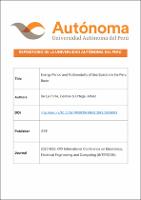Energy Period and Multimodality of Sea Spectra in the Peru Basin

View/
Author(s)
De La Torre, Dennys
Ortega, Arturo
Date
2023Subject
Metadata
Show full item recordPublisher
IEEE
Journal
2023 IEEE XXX International Conference on Electronics, Electrical Engineering and Computing (INTERCON)
Abstract
Assessing the wave energy resource in zones without spectral data leads to assumptions based on theory to estimate wave parameters such as the energy period. The energy period has been regularly approximated using a calibration coefficient based on a standard spectral shape such as the Bretschneider spectrum—representing a single-mode sea state—and the zero-up-crossing period. As a result, assessments of wave energy resources that rely on this practice are only accurate if the spectral shape is single-mode. This work uses spectral data provided by an ocean buoy in the Peru Basin. We presented an algorithm based on comprehensive criteria used in this field to find how many modes the spectrum exhibits. Also, the characteristic periods are estimated using the spectral method in the frequency domain. It is important to study the configuration of maximum energy, or multimodal spectrum, to find the more accurate calibration coefficient or relationship between the energy period and the zero-up-crossing period to estimate the wave power precisely. This procedure, in turn, is important for increasing the reliability of harnessing the wave energy resource through wave energy converters. As the Peru Basin is an open maritime zone, the calibration coefficient may present increased differences in combined sea states with two maximum energy or two modes. The number of modes in the sea spectra should partially explain increased differences in the calibration coefficient. This work aims to find any influence that the presence of multiple modes in the sea spectra has on the calibration coefficient. In conclusion, the sea spectra in the Peru Basin have up to four modes with different behaviours on a monthly time scale. The single or bi-modal spectra exhibit no erratic behaviour. The calibration coefficient’s average for one and two modes ranges from 1.3 up to 1.4 throughout the year. The calibration coefficient for single and bi-modal spectra decreases gradually for the most energetic months and then increases gradually for the less energetic months. As this calibration coefficient is significant to estimate the wave power precisely, using a global average but specific values for each month is not recommended.
Type
info:eu-repo/semantics/article
Rights
info:eu-repo/semantics/restrictedAccess
Language
eng
Collections
- Ingeniería Ambiental [98]

